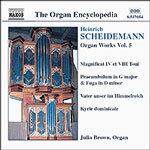
Scheidemann-Organ Works, Vol. 5 (Fuga in D minor, Kyrie dominicale, Magnificat IV Toni, etc)
 $25.00
Out of Stock
$25.00
Out of Stock2-4 weeks add to cart
SCHEIDEMANN
Scheidemann-Organ Works, Vol. 5 (Fuga in D minor, Kyrie dominicale, Magnificat IV Toni, etc)
Julia Brown, organ
[ Naxos The Organ Encyclopedia / CD ]
Release Date: Monday 6 December 2004
This item is currently out of stock. We expect to be able to supply it to you within 2 - 4 weeks from when you place your order.
"Given the Naxos price policy there is no excuse not to collect these Scheidemann recordings, wonderful music, in this instance compellingly played."
- MusicWeb Nov 2004
Born in about 1595 in Wöhrden in Holstein, where his father, a native of Hamburg, had recently been appointed organist, Heinrich Scheidemann studied between 1611 and 1614 with Sweelinck in Amsterdam. His father had moved from Wöhrden by 1604 to take the position of organist at the Catharinenkirche in Hamburg, and the church supported his son's study, In der Hoffnung, dass er ein braver Künstler und dereinst ihr Org. werden sollte (in the hope that he might become a fine artist and some day their organist). When his studies in Amsterdam came to an end Sweelinck wrote a farewell canon for him, with the dedication Ter eeren des vromen Jongkmans Henderich Scheijtman, van Hamborgh, is dit geschreven bij mij, Jan P. Sweelinck, organist tot Amsterdam, op den 12den Novemb. 1614 (For the worthy young man Heinrich Scheidemann of Hamburg this is written by me, Jan P.Sweelinck, organist of Amsterdam, on 12th November 1614). In the late 1620s, and at least by 1629, he succeeded his father as organist at the Catharinenkirche, and in 1633 was appointed clerk of the church, marrying in the following year the daughter of a doctor.
During his years at Hamburg Scheidemann established himself as an important figure in the world of North German organ music. His pupils included J.A.Reincken, later his assistant and successor, Werner Fabricius, who became organist at the Nikolaikirche in Leipzig, Wolfgang Wessnitzer of Celle, Jakob Lorentz of the Waisenhaus in Hamburg, and others of contemporary distinction. He served as a consultant on the construction of new instruments in Brunswick, Lübeck, Bremen and elsewhere, and saw to the enlargement of his own instrument at the Catharinenkirche by the organ-builder Gottfried Fritzsche, with the addition of a Brustwerk to make a four-manual instrument with the existing Hauptwerk, Rückpositiv, and Oberwerk, pedals and 56 stops. He died during an epidemic of the plague in Hamburg in 1663, and his widow, in recognition of her husband's services, received a pension from the city.
Tracks:
Angelus ad pastores ait (after Lassus)
Confitemini Domino primo (after Lassus)
Fuga in D minor
Kyrie dominicale
Magnificat IV Toni
Magnificat VIII Toni (second version)
Omnia quae fecisti (after Lassus)
Praeambulum in G major
Vater unser im Himmelreich II